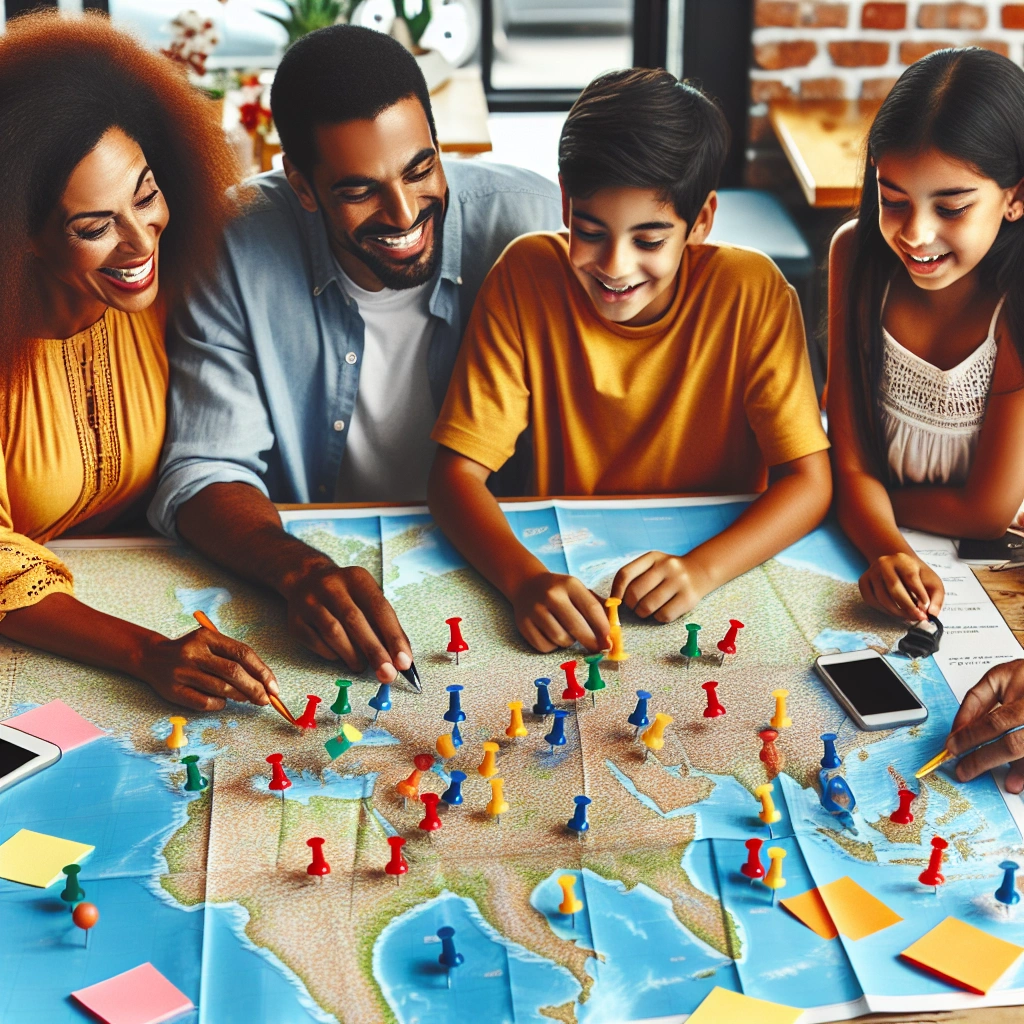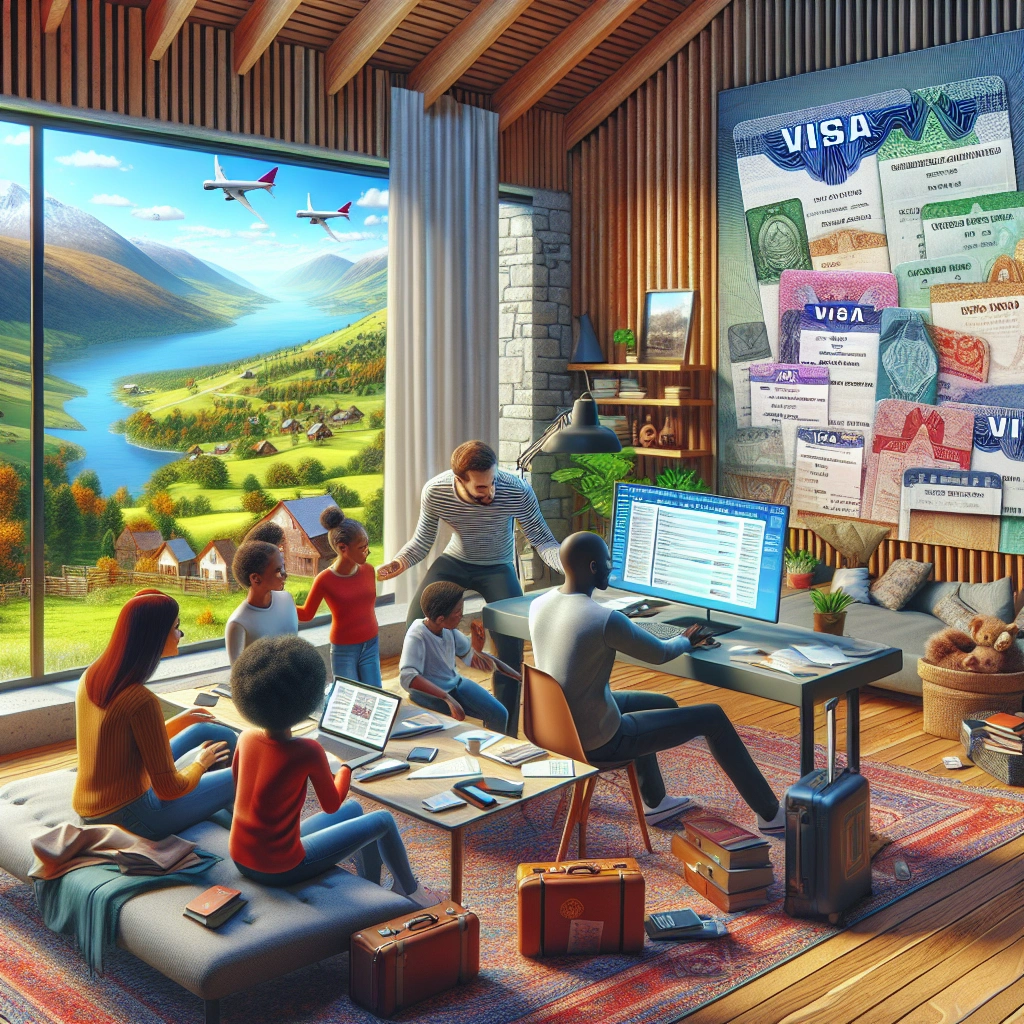

Planning a trip is an essential part of ensuring a smooth and enjoyable travel experience. By carefully considering and organizing the details of your trip in advance, you can save money, reduce stress, and maximize the enjoyment of your adventure.
In this article, we will provide an overview of 8 practical steps for effective trip planning and offer valuable tips to help you make the most of your travel experience. Whether you’re a seasoned traveler or planning your first big trip, these steps and tips will help you navigate the process with confidence and ease.
So, let’s dive into the world of trip planning and discover the benefits of careful preparation for your next journey.
Check out this Youtube video: Discover 5 essential steps for trip planning and gain valuable tips to ensure your next adventure is a success!
Pick your destination
When it comes to researching potential destinations for your next adventure, it’s essential to utilize various resources and tools. One powerful approach involves leveraging online travel platforms such as TripAdvisor and Lonely Planet, as they provide comprehensive insights, user reviews, and destination recommendations.
Additionally, seeking advice from travel bloggers and social media influencers who specialize in adventure travel can offer valuable firsthand experiences to enrich your decision-making process. Exploring community forums and engaging with travel communities on platforms like Reddit can also illuminate hidden gems and unconventional destinations that align with your preferences.
How to choose the best destination for your trip based on your preferences and interests
To effectively choose the best destination tailored to your unique preferences and interests, start by identifying the primary purpose of your trip. Whether you seek thrill-seeking adventure, tranquil beach escapes, or immersive cultural experiences, aligning your travel desires with the destination’s offerings is crucial.
Researching activities and attractions specific to each location can help match your interests with the destination’s allure. Delve into the local cuisine, historical landmarks, and outdoor excursions that resonate with your personal preferences.
Considering factors such as climate, budget, and travel time can further refine your decision and ensure optimal satisfaction with your chosen destination.
Considerations for different types of trips (e.g. adventure travel, beach vacation, cultural immersion)
For thrill-seekers embarking on adventure travel, destinations renowned for adrenaline-pumping activities like bungee jumping, white-water rafting, and trekking through rugged landscapes are ideal. Additionally, prioritizing safety measures, expert guides, and reliable equipment is paramount when engaging in high-risk adventures overseas.
Conversely, for beach vacations, prioritizing accessibility, serene surroundings, and diverse water sports activities can elevate your tropical retreat. Opting for destinations with vibrant beach communities, reputable accommodations, and enchanting coastal scenery can maximize your beach vacation experience.
As for cultural immersion, destinations showcasing rich heritage, authentic traditions, and immersive cultural festivals offer a gateway to experience the world’s diverse and captivating tapestry of human societies.
Decide the duration of your trip
When it comes to deciding the duration of your trip, various factors come into play. First and foremost, the purpose of your trip determines its ideal length.
A business trip may require only a few days, while a leisurely vacation could span several weeks. Additionally, one must consider the destination’s distance and the mode of transportation.
Longer distances often warrant longer stays, as traveling can be physically taxing. Moreover, the activities and attractions you wish to experience at your destination also influence the ideal trip length.
Factors to consider when determining the duration of your trip
The duration of your trip hinges on numerous factors. The first factor is the purpose of your trip.
Whether it’s for leisure, business, or a specific event, the nature of your trip greatly impact its duration. Secondly, consider the distance to your destination and the mode of transportation.
Longer distances might necessitate more extended stays to offset the strain of travel. Moreover, the activities and attractions at the destination also contribute to the ideal trip length.
If you have a comprehensive list of places to visit, you might need more time to explore. Lastly, personal preferences and schedules play a crucial role in determining the duration of your trip.
The impact of trip duration on budget and itinerary planning
The duration of your trip has a substantial impact on both your budget and itinerary planning. Longer trips naturally incur higher expenses, considering accommodation, food, and activity costs.
It also implies a more detailed itinerary to cover all planned attractions. On the contrary, shorter trips are usually lighter on the wallet and demand more meticulous planning to ensure that you get the most out of your limited time.
A well-defined itinerary becomes essential for short trips to make every moment count whereas longer vacations provide more flexibility in scheduling.
Tips for making the most of a short trip versus a longer vacation
For a short trip, it’s essential to plan ahead and prioritize the sights and activities you wish to experience. Having a well-organized itinerary is crucial to maximize your time.
Additionally, packing light can save valuable time and reduce stress during short trips. On the other hand, longer vacations afford more freedom and relaxation.
It’s advisable to plan downtime and flexibility into your itinerary to avoid burnout from overactivity. Exploring different neighborhoods and taking day trips are great ways to make the most of a longer vacation, presenting an opportunity to experience a variety of attractions and environments.
| Factors for Trip Duration | Factors |
|---|---|
| Purpose of the trip | Business, Leisure, Event |
| Distance and transportation | Long distances, Mode of travel |
| Destination activities | Attractions to explore |
| Personal preferences and schedules | Flexibility and convenience |
Set a realistic budget
Establishing a budget for your trip
When it comes to trip planning and tips, setting a realistic budget is crucial for a smooth and enjoyable journey. The first step in establishing a budget for your trip is to determine the total amount of money you are willing to spend. Factor in all possible expenses, including transportation, accommodation, meals, activities, and any unexpected costs that may arise during your travels. It’s essential to research the average costs of these aspects in your destination to ensure your budget is reasonable and realistic.
Cost breakdown for various aspects of travel (flights, accommodations, activities)
Breaking down the costs for different aspects of travel is essential for effective trip planning and budgeting. Start by allocating a specific amount for each category, such as flights, accommodations, and activities. Research and compare prices to get a clear understanding of the average cost for these elements. Utilize online tools and resources to find affordable flight options, consider alternate lodging arrangements like vacation rentals or hostels, and look for free or low-cost activities at your destination.
| Category | Average Cost |
|---|---|
| Flights | $xxx |
| Accommodations | $xxx |
| Activities | $xxx |
| Meals | $xxx |
| Transportation | $xxx |
| Miscellaneous | $xxx |
Tips for saving money while traveling without sacrificing experience
Saving money while traveling is a top priority for many people, and with some smart strategies, it’s possible to save without compromising your travel experience. Consider the following money-saving tips:
- Pack light to avoid excessive baggage fees and maximize mobility.
- Shop at local grocery stores to purchase affordable snacks and meals.
- Bring along your own snacks to avoid expensive airport and convenience store prices.
- Join a rewards program or utilize lounge access for complimentary amenities at airports.
- Opt for off-peak travel times and seasons to secure lower prices for flights and accommodations.
- Prioritize walking or using public transportation to cut down on transportation expenses.
By carefully establishing a budget, comprehensively breaking down costs, and implementing money-saving strategies, travelers can effectively manage their finances while enjoying a fulfilling and memorable trip.
Research and book accommodation
Finding the best accommodation option is crucial for a successful trip. Here’s how to ensure you secure the perfect place to stay for your adventure.
How to find the best accommodation options for your trip
When hunting for the best accommodation for your trip, consider flexibility in your travel dates. This flexibility allows you to take advantage of off-peak rates or last-minute deals. Utilize platforms like Booking and Airbnb to explore a variety of lodging options. Moreover, pay attention to user reviews, as they provide genuine insights into the quality of the accommodation.
Another strategy is to join travel groups on social media platforms. These groups are treasure troves of first-hand accounts and recommendations. By engaging with the community, you can access secret tips and hidden gems, helping you discover the best-kept lodging secrets for a fraction of the regular price.
Booking platforms and resources for comparing prices and amenities
Embrace technology by leveraging booking platforms like Booking.com and Airbnb. These platforms allow you to peruse a multitude of options and filter results based on specific preferences. Additionally, use price comparison resources such as TravelPerk to ensure you’re getting the best deal possible.
A comparative analysis is imperative for making an informed decision. Research amenities, read customer reviews, and meticulously compare prices to ensure you’re getting the most value for your money.
Platforms like TravelPerk enable you to embark on a well-informed accommodation booking journey.
Considerations for different types of travelers (solo, family, luxury, budget)
Tailoring accommodation decisions according to the nature of your trip is indispensable. For solo travelers, hostels and shared spaces can foster a sense of community and provide excellent value for money. Conversely, for family trips, prioritize safety, space, and family-friendly amenities. Luxury travelers should seek opulent accommodations that offer unparalleled comfort and indulgence. On the other hand, budget travelers should focus on cost-effective options without compromising on safety and cleanliness.
| Type of Traveler | Accommodation Considerations |
|---|---|
| Solo | Hostels, shared spaces, and community-oriented settings. |
| Family | Safety, space, and family-friendly amenities. |
| Luxury | Opulent accommodations with lavish comfort. |
| Budget | Cost-effective options without compromising on safety and cleanliness. |
Book flights, train, or bus tickets, and accommodation
Comparison of different transportation options
When selecting transportation for your trip, it’s crucial to consider various factors, such as cost, travel time, and convenience. Flying is often the fastest mode of travel for long distances, making it ideal for time-sensitive journeys. On the other hand, driving provides the flexibility of having a car at your destination and is suitable for shorter distances, especially with multiple passengers. However, for cost-effective group travel, charter buses offer door-to-door convenience, enhanced comfort, and eco-friendly benefits.
| Transportation Mode | Key Considerations |
|---|---|
| Flying | Fastest for long distances |
| Driving | Flexibility for shorter distances |
| Charter Buses | Cost-effective and convenient for groups |
How to find the best deals on flights and transportation
Securing affordable transportation deals is essential for budget-conscious travelers. When aiming to score cheap flights, flexibility is key. Considering different destinations and dates based on price can lead to significant savings. Advanced booking, utilizing loyalty programs, and monitoring fare alerts are effective strategies. For last-minute flights, leveraging specialized booking platforms and being open to connecting flights maximizes the chances of finding cost-effective options.
Tips for booking accommodation that aligns with your travel plans and preferences
Booking the right accommodation greatly impacts the overall travel experience. To ensure that your stay aligns with your preferences, consider various factors such as price, location, amenities, and reviews. Additionally, the number of people in your group and check-in/out times are crucial elements to factor in. By conducting thorough research and consulting trusted review sites, you can identify accommodations that perfectly align with your travel plans and preferences.
Research local transportation options
Navigating local transportation in different destinations
When navigating local transportation in different destinations, it’s crucial to gather information on the available options in advance. Research the public transit systems, including buses, subways, trams, and trains, and identify their respective routes and schedules. Investigate the availability of ride-sharing services and taxi options. Additionally, consider the feasibility of walking or biking to reach nearby attractions or landmarks. By obtaining a comprehensive understanding of the local transportation network, travelers can efficiently plan their movements within the destination while maximizing their time and resources.
The benefits of public transportation versus renting a car
The benefits of public transportation over renting a car are numerous. Public transit offers a cost-effective and environmentally friendly means of getting around, reducing the burden of parking expenses and fuel costs. Moreover, it enables travelers to immerse themselves in the local culture and interact with residents, allowing for a more authentic and enriching experience. Conversely, renting a car provides greater flexibility and convenience, especially when visiting remote or less accessible areas. It also offers the freedom to customize travel itineraries and explore off-the-beaten-path locations. The choice between public transportation and renting a car hinges on individual preferences and the specific requirements of the trip.
Planning for transportation within your destination, including cost considerations
When planning for transportation within your destination, cost considerations play a pivotal role in decision-making. Evaluate the expenses associated with various transportation options, factoring in ticket prices, fuel expenses, parking fees, and potential tolls. Utilize online resources to compare public transportation fares with the cost of renting a car, taking into account any available discounts or promotional offers. Additionally, ascertain the impact of transportation choices on the overall trip budget and prioritize allocating funds based on the importance of seamless and convenient mobility. By proactively planning for transportation costs, travelers can optimize their financial resources and enhance the overall travel experience.
| Pros of Public Transportation | Cons of Renting a Car |
|---|---|
| Cost-effective | Greater flexibility |
| Environmentally friendly | Parking expenses |
| Cultural immersion | Fuel costs |
| Efficient urban mobility | Customized itineraries |
Create a flexible itinerary
When it comes to trip planning and tips, creating a flexible itinerary is crucial for a successful and enjoyable travel experience. The importance of flexibility in travel planning cannot be overstated, as it allows for adaptability to changing circumstances and maximizes the potential for spontaneous exploration and relaxation.
The importance of flexibility in travel planning
Flexibility in travel planning enables travelers to embrace unexpected opportunities and adjust their itineraries based on current circumstances, such as weather conditions, local events, or personal preferences. It also reduces stress and allows for a more relaxed and enjoyable travel experience.
By being open to change, travelers can take advantage of unique experiences that may not have been included in a rigid itinerary. Moreover, flexibility enhances the overall sense of freedom and adventure associated with travel, contributing to unforgettable memories and experiences.
Tips for structuring your itinerary to allow for spontaneity
To create a flexible itinerary, it is essential to strike a balance between planned activities and unplanned time. One effective approach is to limit the number of main activities per day, allowing for potential changes or additional discoveries.
Grouping activities by location, theme, or priority can also facilitate easier adjustments based on mood, energy level, or unforeseen opportunities. Utilizing digital mapping tools can aid in identifying nearby attractions, dining options, or points of interest, offering the flexibility to make spontaneous decisions while on the go.
While planning, it’s important to incorporate “chill days” into the itinerary, where no activities are scheduled, providing an opportunity for relaxation, rejuvenation, and impromptu exploration. This deliberate inclusion of downtime contributes to a more balanced travel experience, preventing fatigue and allowing for moments of serendipity.
Being open to last-minute changes and remaining agile in the face of unforeseen circumstances can further enhance the flexibility of the itinerary, allowing for new discoveries and unexpected delights.
Balancing planned activities with downtime for relaxation and exploration
Achieving a harmonious balance between scheduled activities and downtime is fundamental for a flexible travel itinerary. By strategically allocating time for relaxation and exploration, travelers can prevent burnout and maximize enjoyment throughout their journey.
It’s essential to assess the pace of travel, accommodating for rest and reflection as well as high-energy excursions. This balanced approach supports the preservation of energy and enthusiasm for planned activities, ensuring that each experience is enriched by a sense of spontaneity and leisure.
An adaptable and loose itinerary enhances the overall travel experience, fostering a sense of curiosity, excitement, and openness to new possibilities. By integrating the tips for structuring an itinerary with flexibility, travelers can create a transformative journey that embraces the unexpected and celebrates the joy of exploration.
Balancing planned activities with downtime contributes to a more holistic and fulfilling travel experience, enriching the soul with cherished memories and authentic encounters.
| Day | Planned Activities | Downtime/Exploration |
|---|---|---|
| Day 1 | Museum visit | Leisurely local cafe visit |
| Day 2 | Guided city tour | Relaxing park stroll |
| Day 3 | Hiking excursion | Spontaneous shopping |
| Day 4 | Cultural event attendance | Free day exploration |
| Day 5 | Culinary class attendance | Evening local market visit |
Plan the day-wise activities and course of action
When planning your daily activities and sightseeing, it is important to research the top sights, landmarks, and experiences in your chosen destination. Creating a flexible day-by-day plan allows for downtime and unexpected discoveries along the way. Prioritize your activities based on personal preferences and allocate sufficient time for each. This ensures a well-structured itinerary that optimizes your travel experience and allows for serendipitous encounters.
How to plan your daily activities and sightseeing
In planning your daily activities and sightseeing, start by researching the popular attractions, landmarks, and unique experiences your destination offers. Once you have a list of potential activities, begin to organize them into a day-by-day plan.
Consider the proximity of attractions to ensure efficient travel between locations and to avoid unnecessary backtracking. It’s essential to factor in downtime, leisurely meals, and flexibility for impromptu discoveries.
This approach allows for a balance between structured plans and spontaneous exploration, enhancing the overall travel experience.
When incorporating must-see attractions and off-the-beaten-path experiences, it is beneficial to strike a balance between famous landmarks and hidden gems. Prioritize the must-see attractions that align with your interests and offer renowned cultural or historical significance. Complement these experiences with off-the-beaten-path adventures, which unveil the authentic charm of a destination. This blend provides a comprehensive and enriching travel experience, combining iconic highlights with unique, lesser-known encounters.
Incorporating must-see attractions and off-the-beaten-path experiences
Include renowned landmarks like the Eiffel Tower in Paris or the Grand Canyon in your itinerary, ensuring you don’t miss out on iconic sites. At the same time, seek out hidden treasures like local markets, neighborhoods, or lesser-known historical sites that capture the soul of the destination.
Engaging with the local culture and traditions through off-the-beaten-path experiences adds depth to your journey, making it memorable and distinctive.
When it comes to managing expectations and avoiding over-scheduling, the key is to embrace flexibility and spontaneity. Limiting your daily itinerary to one or two main activities provides a focused approach, allowing ample time to savor each experience. This ensures that you don’t feel rushed and have the freedom to immerse yourself fully in each encounter. By maintaining a balance between planned activities and unscripted moments, you can avoid over-scheduling and embrace the joy of newfound discoveries.
Managing expectations and avoiding over-scheduling
Embrace the concept of expectation-free time within your itinerary, allowing yourself the liberty of wandering without a fixed agenda. By carving out spaces for unexpected indulgences or leisurely exploration, you can savor the essence of your destination without feeling constrained by a rigid schedule.
Additionally, avoid over-scheduling by being mindful of the time required for each activity and factoring in adequate relaxation periods. This approach fosters a harmonious journey, free from the pressures of a tightly packed schedule.
In crafting your travel itinerary, it’s crucial to blend meticulous planning with the spontaneity of exploration. By incorporating a mix of must-see attractions and off-the-beaten-path experiences into your daily activities, you can create a journey that is both comprehensive and captivating.
Embracing flexibility and managing expectations ensures a well-balanced itinerary, allowing you to immerse yourself in the essence of each destination and cultivate unforgettable memories.
| Day | Activities | Must-See Attractions | Off-the-Beaten-Path Experiences |
|---|---|---|---|
| Day 1 | City Tour | Landmark A, Museum B | Local Market, Hidden Garden |
| Day 2 | Historical | Site Visit, Cultural Performance | Artisan Workshops, Neighborhood Walk |
| Day 3 | Nature Hike | Scenic Trail, Natural Wonder | Wildlife Sanctuary, Riverside Picnic |
Check passport and visa requirements
Understanding passport and visa requirements for international travel
When planning an international trip, it is crucial to understand the passport and visa requirements for the intended destination. Each country has its own set of entry rules, and being aware of these requirements is vital to prevent any hassles or rejections during travel. The validity period of the passport is also important, as some countries require it to be valid for at least six months beyond the date of entry.
In addition to the passport, a travel visa may be essential for entry into certain countries. The visa requirements often depend on the purpose of the visit, such as tourism, business, or study. Ensuring that one possesses the obligatory visa for the intended stay duration is critical to avoid any legal or immigration issues during international travel.
How to ensure your travel documentation is in order
To ensure that all travel documentation is in order, one should begin by checking the validity of their passport. If the expiration date is approaching or has passed, it is advisable to apply for a renewal well in advance. For visa requirements, researching the specific entry regulations of the destination country is essential. This may involve visiting the embassy or consulate’s website, providing valuable insights into the visa application process, required documentation, and processing times.
Furthermore, to minimize the risk of documentation-related issues during the trip, it is recommended to maintain digital and physical copies of essential documents such as the passport, visa, travel insurance, and emergency contacts. Having these readily accessible can streamline the identification process and assist in the event of passport loss or theft while overseas.
Resources for obtaining visas and managing necessary paperwork
There are various resources available for obtaining visas and managing necessary paperwork for international travel. The official websites of the destination country’s embassy or consulate typically offer comprehensive information regarding visa applications, required forms, and supporting documentation.
Additionally, specialized visa agencies and travel consultants can provide valuable assistance and expedite the visa application process, ensuring that all necessary paperwork is organized and submitted correctly.
Moreover, for travelers planning a multi-destination trip or visiting countries with stringent visa requirements, employing the services of a professional travel agent or visa consultant can streamline the process and alleviate the complexities associated with obtaining multiple visas. These experts possess extensive knowledge of entry regulations and can offer tailored advice to ensure that the necessary visas are secured in advance of the journey.
| Resource Name | Description |
|---|---|
| U. S. Department of State | Provides comprehensive information on passport and visa requirements for American citizens traveling internationally. |
| Destination Embassies/Consulates | Primary sources for visa application procedures and required documentation based on the specific country of visit. |
| Visa Agencies/Consultants | Offers professional guidance and assistance in the visa application process, facilitating a smooth travel documentation experience. |
Recommended Amazon Products for Trip Planning and Tips
Here’s a curated list of products that can help you achieve a successful and well-prepared trip. These recommendations are based on functionality, price, and reviews.
Travelambo Leather Luggage Bag
The Travelambo Leather Luggage Bag is a stylish and durable travel bag that is perfect for carrying your essentials. With multiple compartments and a sleek design, this bag offers both functionality and style. This product comes with multiple color options to suit your preferences. Check it out on Amazon


Lonely Planet Travel Guide
The Lonely Planet Travel Guide is a comprehensive resource for researching potential destinations and planning your itinerary. With detailed information on various destinations, it provides valuable insights for travelers of all kinds. This guidebook is highly recommended for its detailed and up-to-date content. Check it out on Amazon


Shacke Pak Travel Packing Cubes
Shacke Pak Travel Packing Cubes offer an organized and efficient way to pack your clothes and essentials. With various sizes and colors, these packing cubes are designed to fit inside your luggage and keep your belongings neatly organized. This product is praised for its durability and convenience. Check it out on Amazon


Zoppen Multi-purpose Travel Wallet
The Zoppen Multi-purpose Travel Wallet is a versatile and functional accessory that helps you keep your travel documents, cards, and cash organized. With RFID blocking technology, it ensures the security of your personal information. This travel wallet is known for its practical design and durability. Check it out on Amazon


Anker PowerCore Portable Charger
The Anker PowerCore Portable Charger provides reliable and fast-charging power for your electronic devices while traveling. With multiple charging ports and high capacity, it’s a convenient solution for keeping your devices powered throughout your journey. This portable charger is highly recommended for its efficiency and compact design. Check it out on Amazon


Top Recommended Product for Trip Planning and Tips
If you’re looking for the best solution for trip planning and tips, we highly recommend the Travelambo Leather Luggage Bag. Here’s why:
| Pros | Cons |
|---|---|
| Stylish and durable design | May be pricier than other options |
| Multiple compartments for organization | Limited color options Highly-rated functionality |
Check it out on Amazon
Ready to improve your trip planning experience? Check out the Travelambo Leather Luggage Bag


Frequently Asked Questions
What is the best way to plan a trip?
What 4 things do you need to consider when planning a trip?
How do I organize my trip plans?
What are the do's and don'ts while planning a trip?
What is the best way to plan a travel itinerary?
Reference Links
- https://www.northsouthtravel.com/5-reasons-why-having-a-travel-itinerary-is-important
- https://www.nerdwallet.com/article/travel/how-to-find-cheaper-last-minute-flights
- https://blog.locus.sh/calculate-transportation-costs-logistics/
- https://www.hotelpricereporter.com/blog/hotel-rate-monitoring/
- https://www.linkedin.com/advice/0/what-some-tips-managing-your-time-when-you-ksjfc









